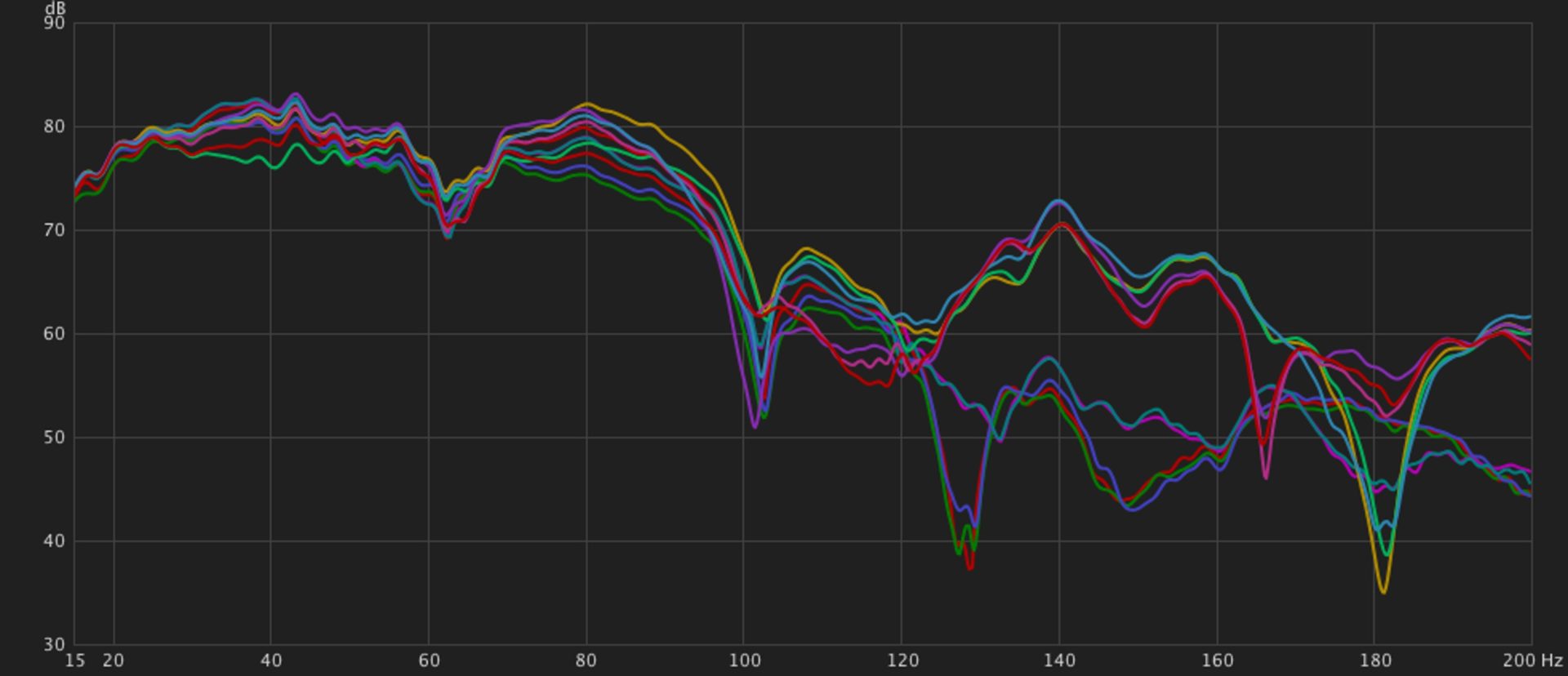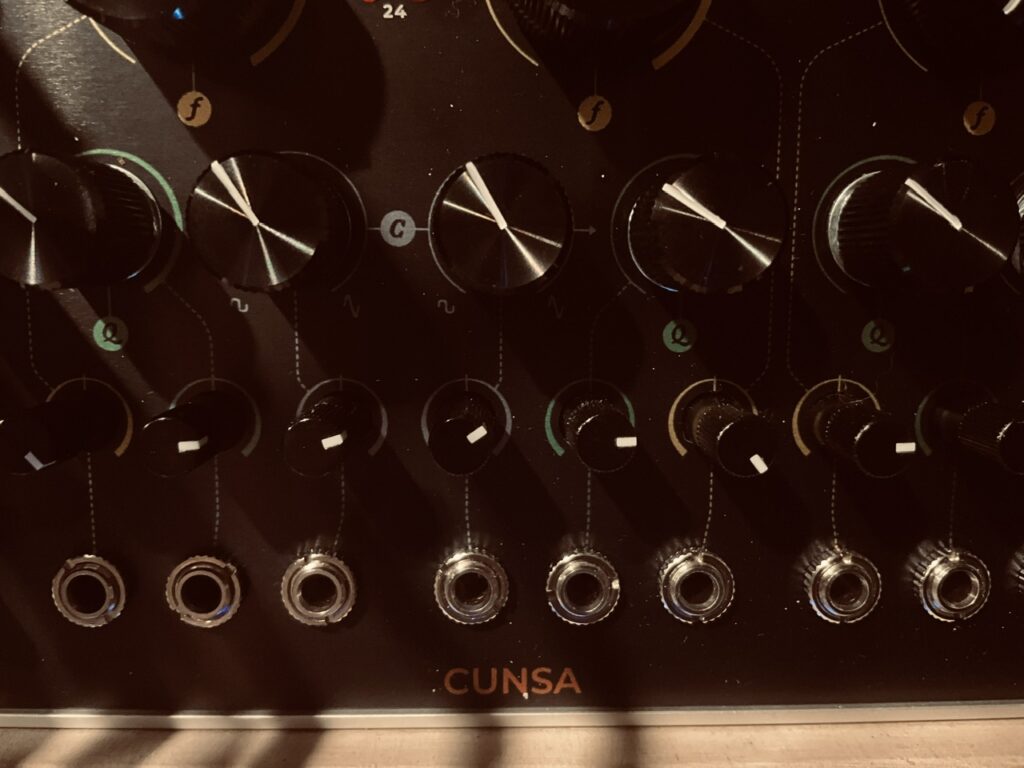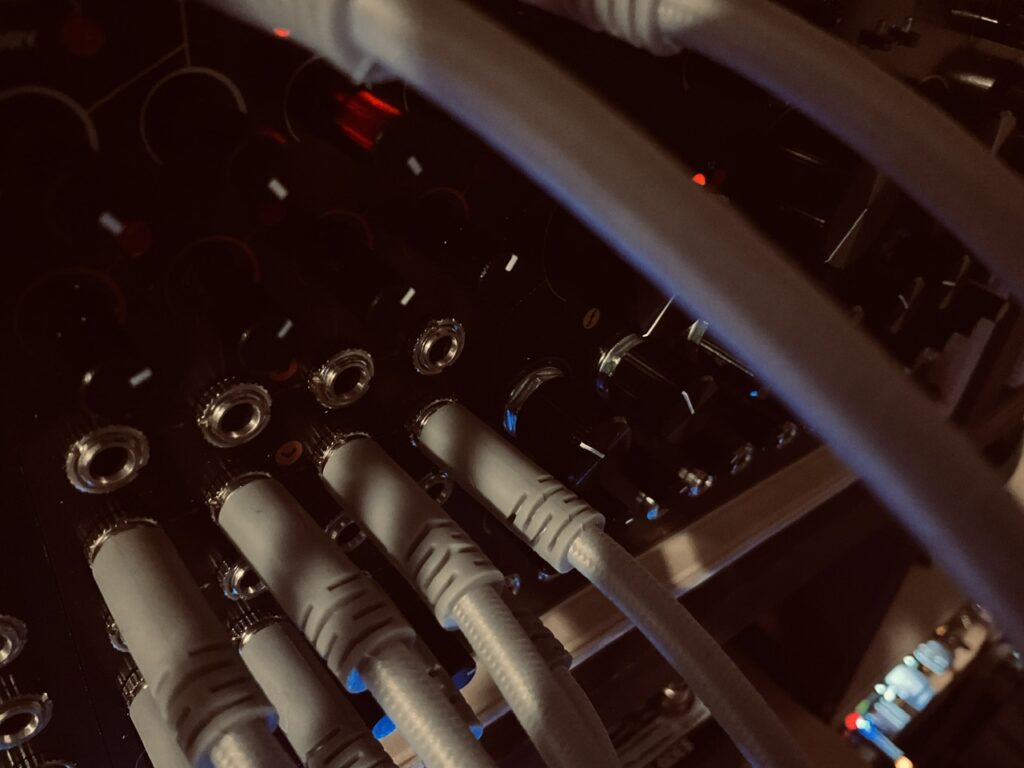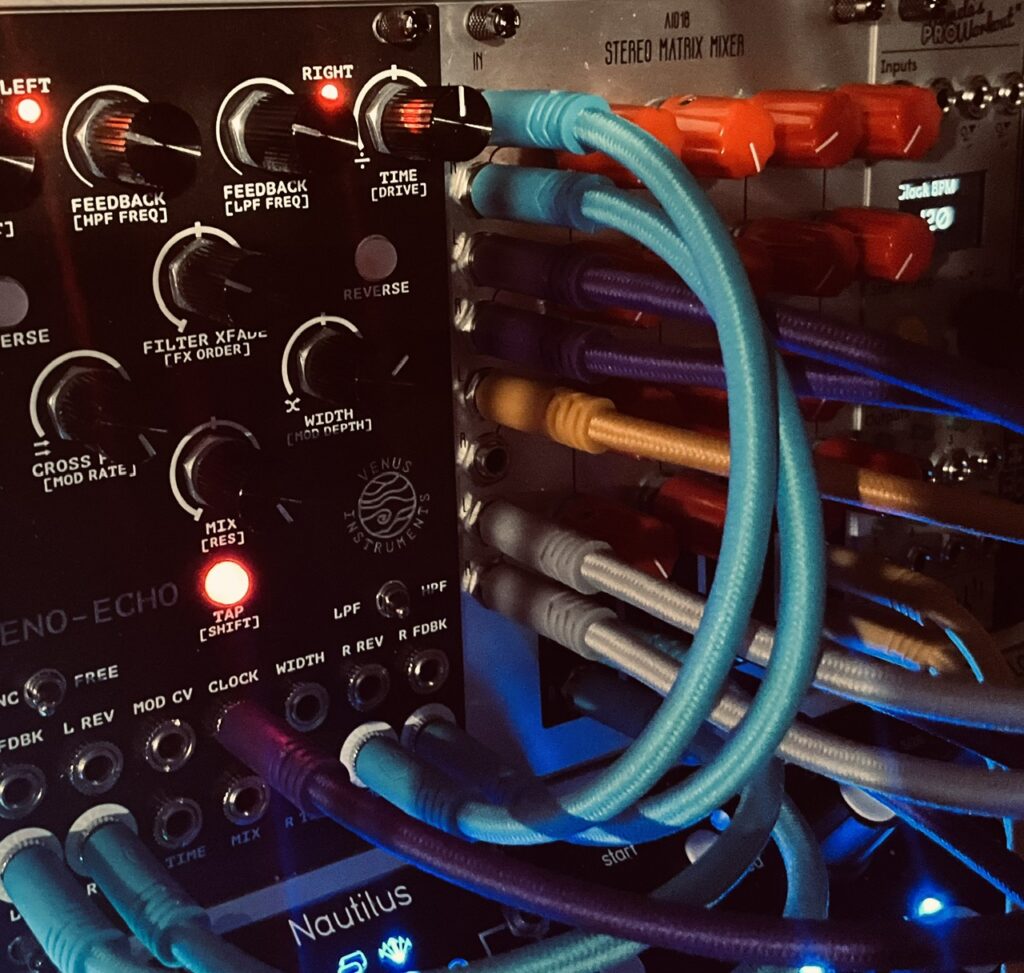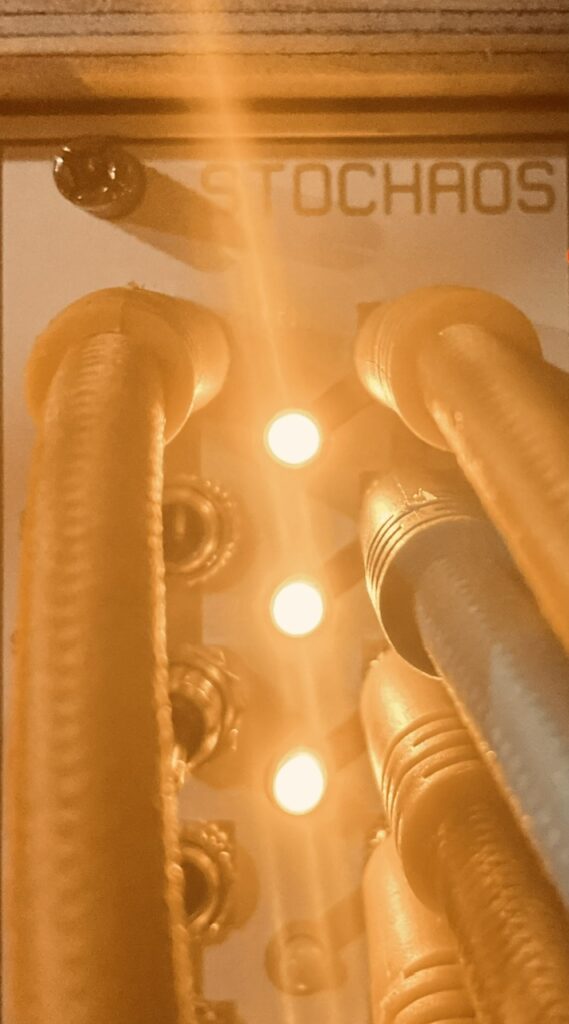Since I’ve recently received several modules, I’ve been using them rather heavily of late, and they’ve kind of taken front and center. The Nonlinearcircuits Stochaos and Humble Audio Quad Operator are featured in many of my recent patches, and this is no exception. I wasn’t sure, exactly, what I wanted with this patch, but I knew I wanted a chaos clock that was moving fast. I wanted lots of gates firing quickly, and use those gates to hit 4 separate LPGs, this time a pair of Tokyo Gates. Then I knew I wanted these quickly firing notes to be heavily delayed, and sent to a resynthesizer to fill in space and give something for those quickly firing notes and repeats to swim in. I wasn’t imagining bubbles when I first started, but that’s what I kept coming to as I was fiddling with the patch, and after a while leaned into this theme a bit to see where I could take it.
Getting a fast chaotic clock was the easy part. I’ve been using chaos-based clocks almost exclusively for a few months. I don’t mind a grid, but most of my creative inclinations are more towards malleable textures, and chaos provides an almost perfect ebb and flow. At slow tempos it’s definitely noticeable, but this patch was to be clocked at a very high rate; perhaps even approaching audio rate, and those differences at high rate are much less noticeable As per usual, I sent the modulated chaos signal to Divide & Conquer, before sending a fast division to Stochaos. From there the chaos-generated gates would go to the CalSynth Changes to create some snappy decay envelopes that would hit the CV input of four separate Tokyo Gates. The outputs of the Tokyo Gates were mixed into 2 signals in the Mutable Instruments Veils, and finally sent to the AI Synthesis 018 Stereo Matrix Mixer.
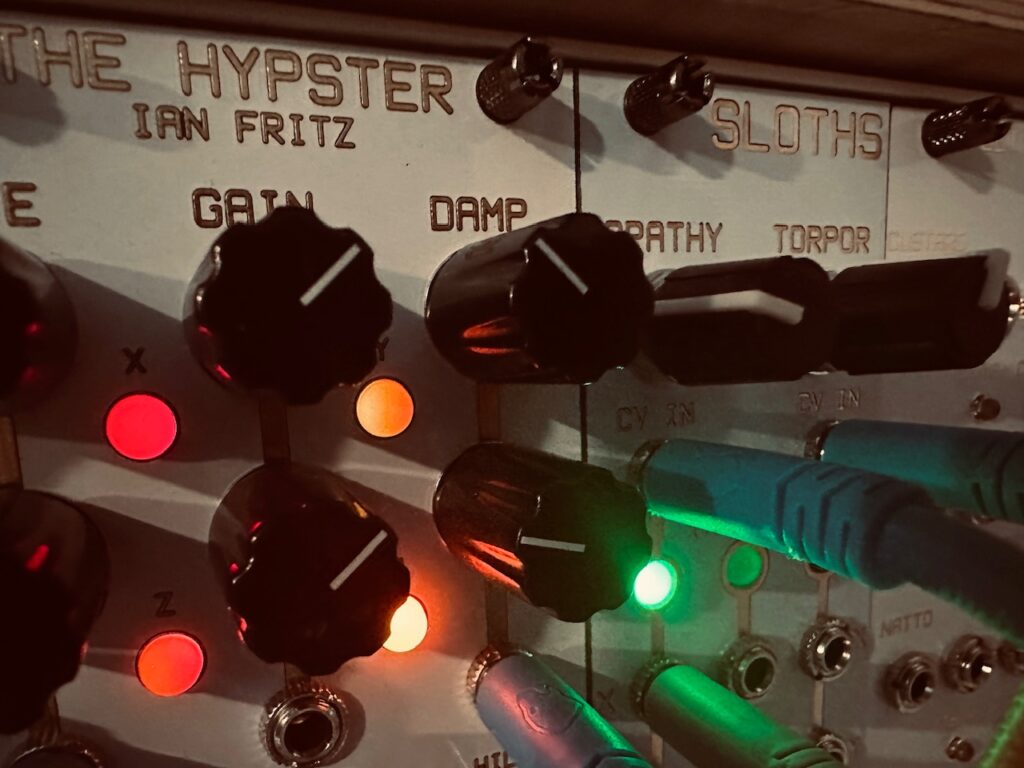

The audio is from the 4 operators of the Humble Audio Quad Operator. Although I initially experimented with tweaking the wave shape of the operators, several times, actually, I settled on sine waves. I also tried to work in some FM, but I couldn’t find exactly what I was looking for, which is likely because I was using all 4 operators as carriers, rather than trying to use just a couple of the oscillators as carriers, with the others acting as modulators. It’s tough to get oscillators to behave when you have lots of cross frequency modulation happening. Generally it’s pretty pedestrian as far as the audio source, but there are so many individual notes that are echoed so many times that anything much more complex might be a wall of sound rather than something more enunciated.
The pitch signal is taken from a slow chaos wave through Xaoc Devices Samara II for some careful offset and attenuation before going to uO_C’s Quantermain for quantization into D minor (even if I have no idea what the oscillator is actually tuned to), before being sent to the v/oct input on the Quad Operator. That accounts for the generally up and down nature of the pitch progression. It’s also a good example on how chaos operates. It’s steady-ish, but there are definitely times when the chaos deviates from its path. Sometimes that means speeding up or slowing down. Sometimes that means direction reversals. Sometimes it means lingering at some pitches longer than others. You think you know what’s going to happen, but then the chaos surprises you, providing something interesting. Even still, I feel like there is too much of the same thing when it comes to the pitch in this patch, but since it was more an exploratory patch I think I can forgive myself.
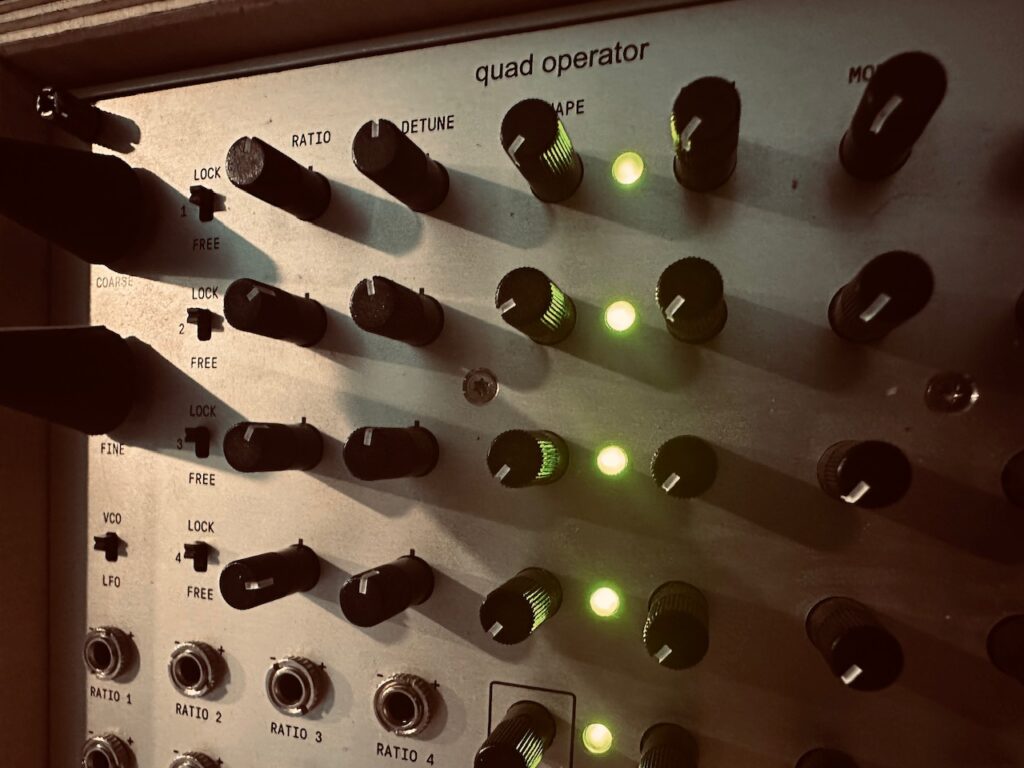
I recently became aware to the dismal fact that my main synth, a large set of separate subsystems that comprises 1,560hp and that has another 588hp in interchangeable subsystems, did not have a vactrol-based LPG in it. Despite having several vactrol LPGs from the Make Noise LxD and Optomix, to the Nekyia Sosumi, and still more, not a single one was in my main case. All of them had been moved to either my Make Noise Satellite Subsystem, or else my Side Case. I have plenty of non-vactrol-based LPGs like the Rabid Elephant Natural Gate, Bard Synthesizers VTG, Frap Tools CUNSA, and Verbos Amp & Tone in the main case, but not one vactrol LPG. As soon as I came to this realization I knew that it couldn’t stand for a single moment longer, and moved a pair of Tokyo Tape Music Center Tokyo Gates from my side case back to the main case. I’d get 4 channels of my favorite vactrol LPG to go along with all of the additive-style oscillators I tend to gravitate towards. Three Body, Quad Operator, Algo, Mob of Emus, and many others besides pair so naturally with a LPG that it seems boneheaded to not have them ready for the occasion.
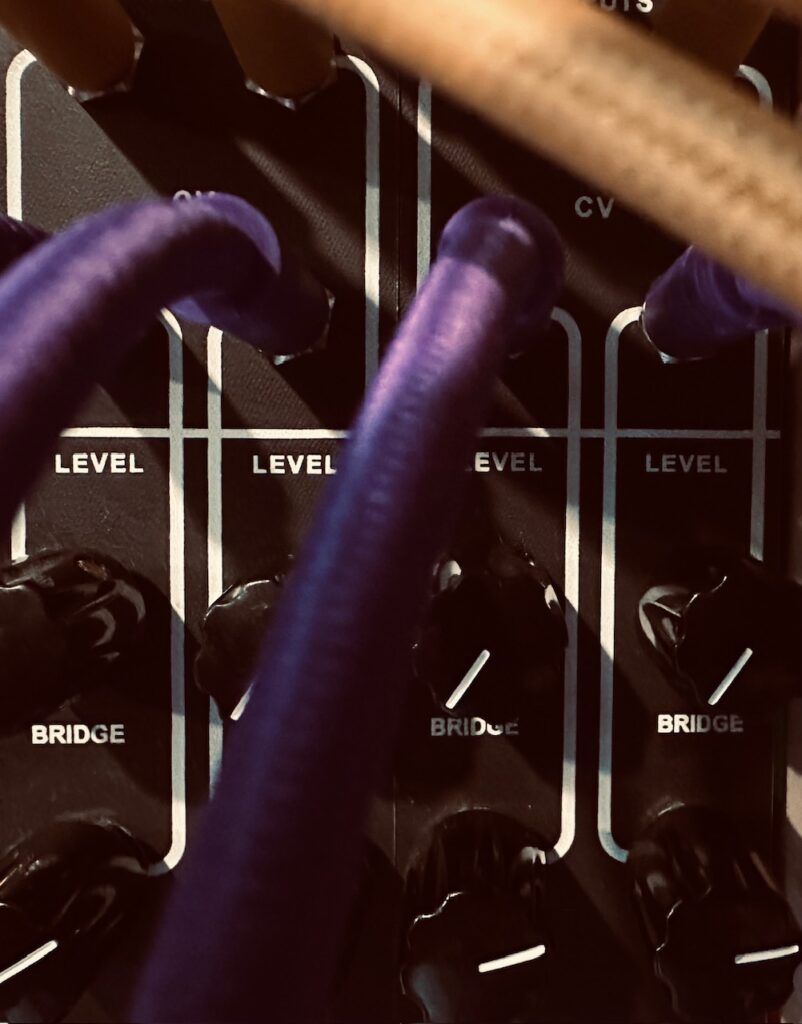
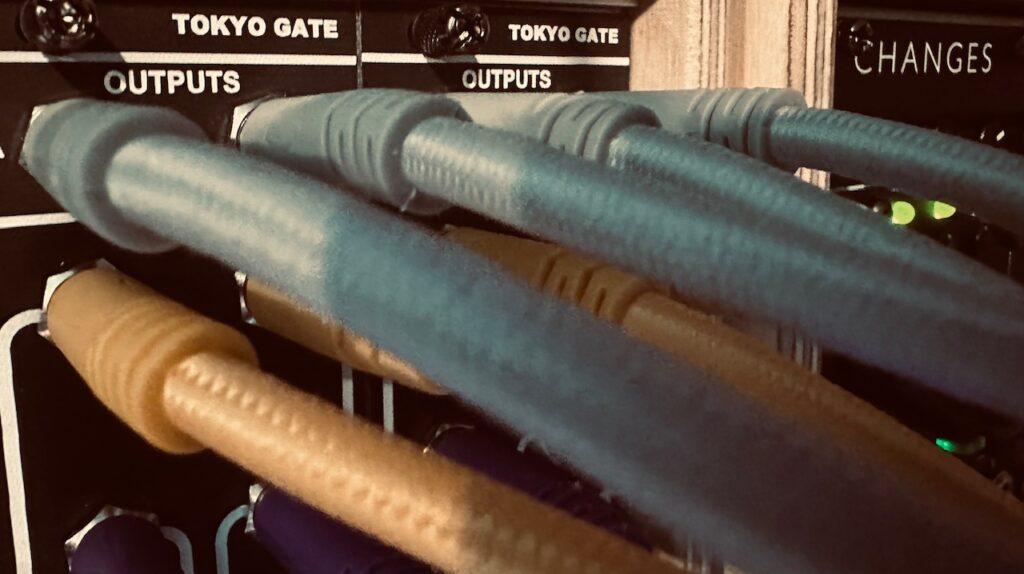
I’ve liked LPGs for a long time. My first foray was via the Make Noise Optomix, which quickly led to several others, both with and without vactrols. I like both types, but it’s the non-exactness of vactrols that really draws my ear. They can be a little sloppy, particularly when hit repeatedly with a gate or envelope. Vactrol-less LPGs like the Natural Gate or DXG too sound great, but there’s something about their precision that doesn’t feel the same as with vactrols. It’s almost too perfect, and too repeatable. I also feel that vactrols bleed prettier, which is a patching technique I love to use. I don’t know whether I was insistent in using vactrol LPGs in this patch because I thought they’d be best, or because I had just put four of them back in my main case, but I decided on using the venerable Tokyo Gate.
Even if I don’t use Tokyo Gate very often, it is my favorite of the vactrol LPGs I’ve had. Its decay is adjustable (to a degree) with the Bridge control, pleasant, and even can have a little squelch of resonance if you pin the Bridge knob full CW. Although you can directly ping Tokyo Gate with a trigger or gate just fine, I’ve found that envelopes generally sound more pleasant to the ear. There’s a harshness with slamming a gate into that isn’t there when using a well shaped decay envelope.


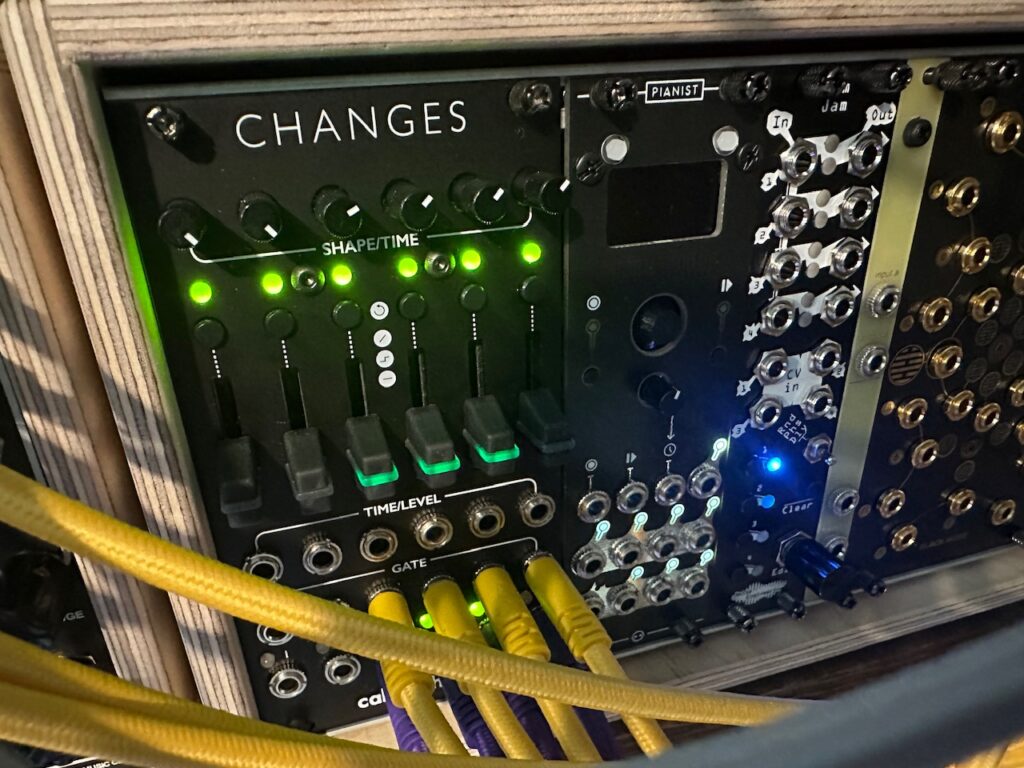
In this patch, because I was using sine waves, the Tokyo Gate probably performs not much different than a regular VCA. There are no harmonics in a sine wave to reveal and hide again as the filter also goes up and down with the volume, but you still get that vactrol decay which can’t really be had with anything else. I also liked the perceived sloppiness of the vactrols as they were being repeatedly hit by envelopes. All of the chaos-derived gates flying about in rapid succession, triggering short, snappy envelopes started to resemble four separate telegraph signals flying about in space.
And although the effect of four vactrol LPGs pinging away was pretty cool, I knew that I wanted a lot more of it by using delay. These pings were the start, not the end. Far from it. Rather than using one delay like I normally might, I opted to use two of them in parallel.
Delay number one was the Venus Instruments Veno-Echo. Its reverse function per channel was being modulated by chaos-derived gates from the very slow end of the Divide & Conquer. Since the original chaos clock signal itself was running quite fast, even very low divisions would trigger too frequently for me, and decided to run those gates through the CuteLab Missed Opportunities gate probability utility that I tend to use in most of my patches.
The second delay is the Olivia Artz Modular Time Machine. Using various delay taps would ensure the effervescent feeling I was getting as the patch started to take some shape, spraying delays all about the stereo space. Besides creating that bubbly feeling I was now striving for, the Time Machine is also the source audio for the Qu-Bit Aurora resynthesis module that fills in the gaps and helps create something thicker for those bubbles to float in.
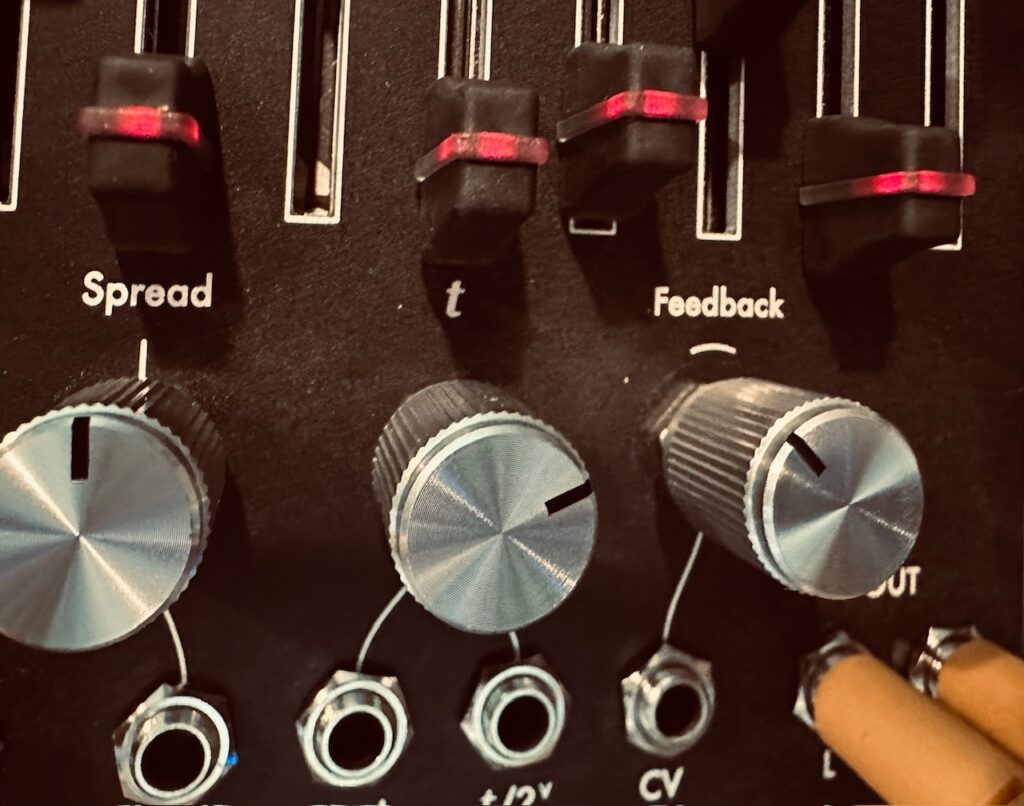
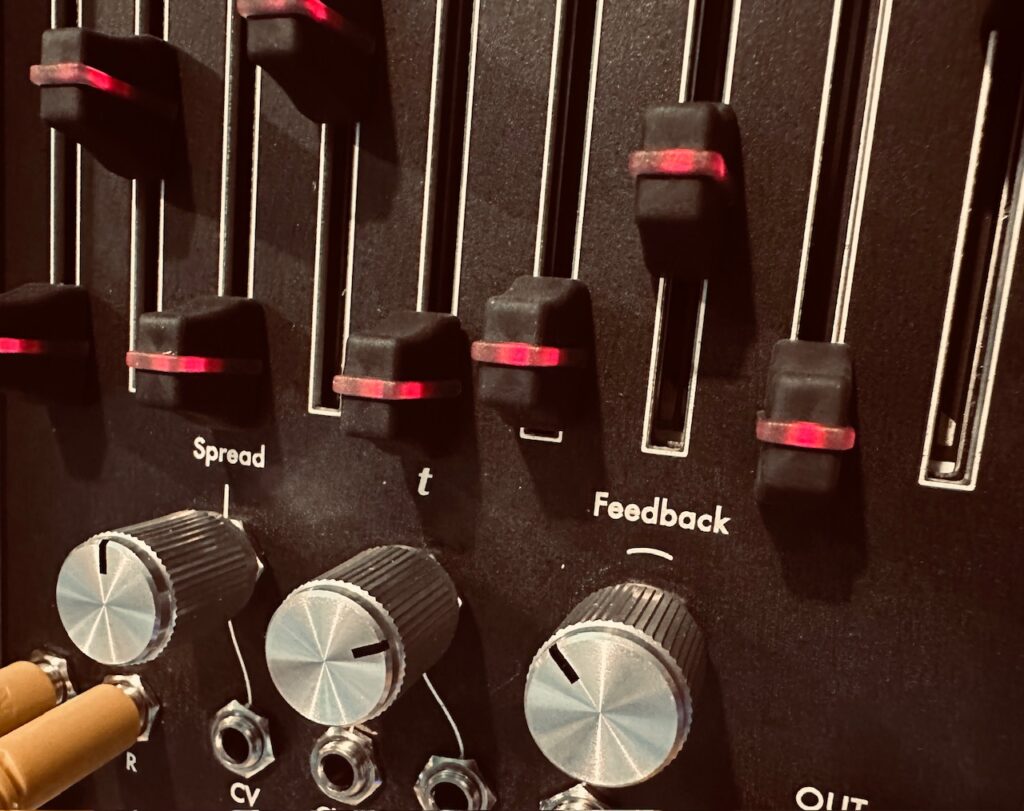
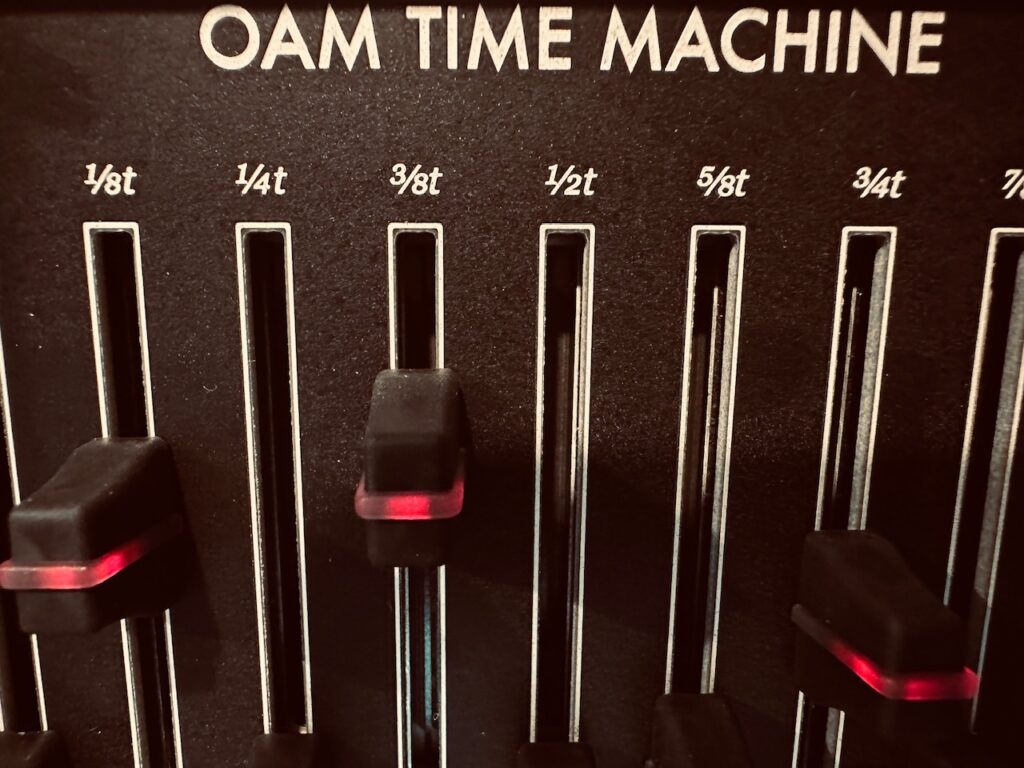
Altogether we have the feeling of bubbles floating around space. One thing I might try in a future patch like this is to use the pitch as CV for the clock rate. As the pitch changes, so too does the clock, creating more gates with higher pitched bubbles, and fewer with lower pitched bubbles. I’d also be a bit more inventive with my pitch sequence as well. This is just a chaos signal triggering Quantermain as it moves through from note to note in the selected scale. Even if I want to use chaos as a source for pitch, in order for there be some quality pitch movement I’d be better off using one of the chaos derived gates to trigger the quantizer via some labyrinth of gate probability, logic, and/or a Bernoulli Gate.
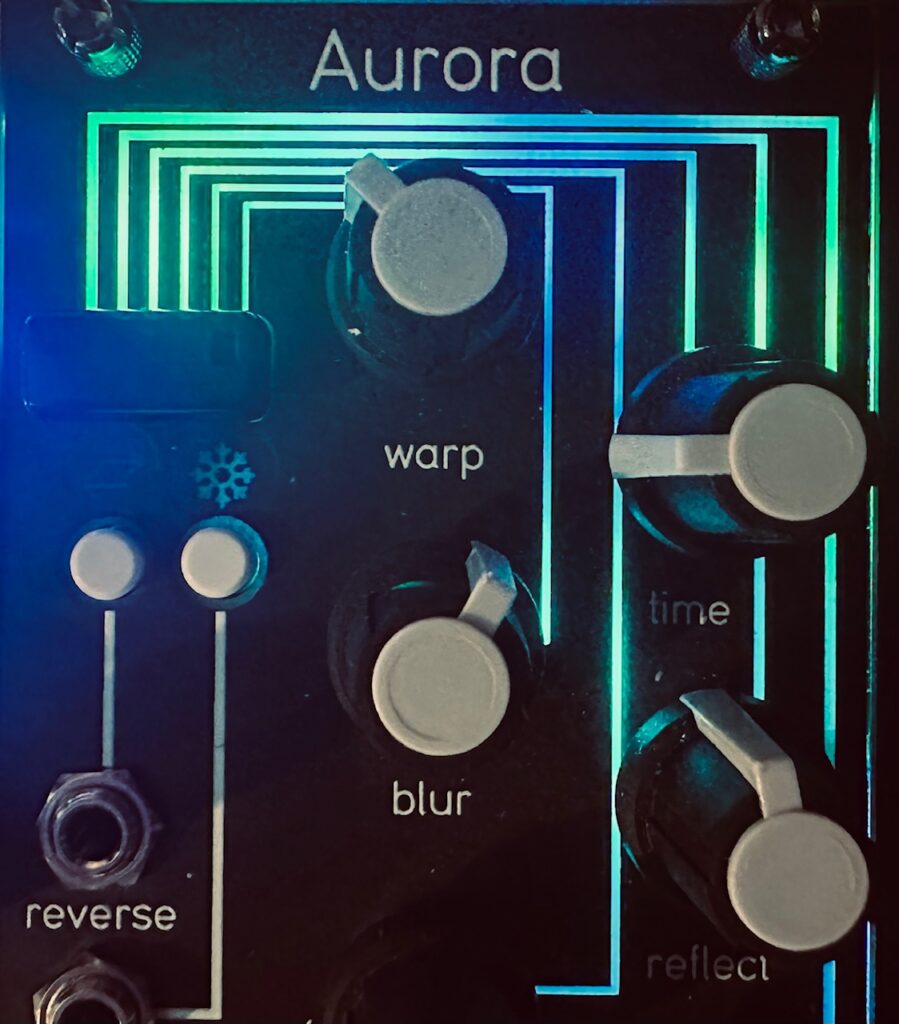
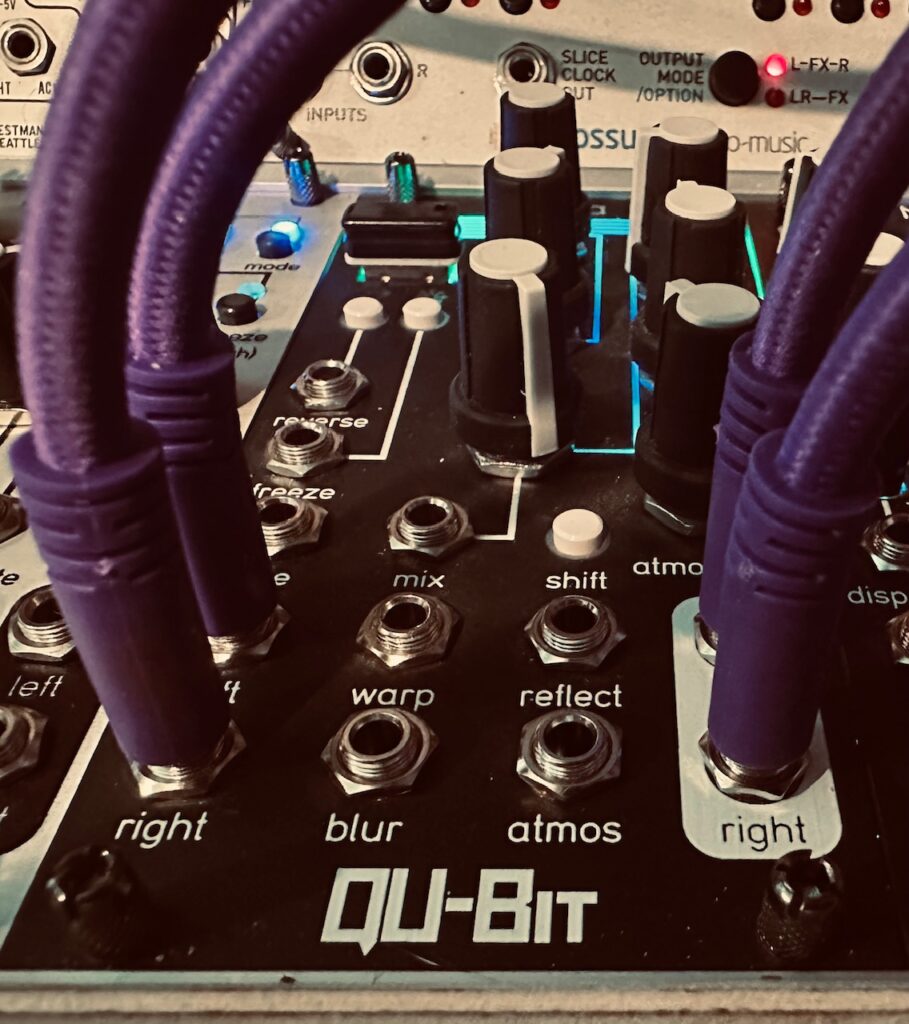
Altogether there isn’t anything special about this patch other than it was experimentation throughout. Experimentation with chaos as pitch. Experimentation with extremely fast gates with vactrol LPGs. Experimentation with delay taps to get a good feeling of watching bubbles in a freshly poured glass of Coke. Experimenting with parallel delays. Experimenting with Aurora.
Modules Used:
Nonlinearcircuits The Hypster
Nonlinearcircuits Divide & Conquer
Nonlinearcircuits Stochaos
Nonlinearcircuits Triple Sloth
Xaoc Devices Samara II
CalSynth uO_C
Humble Audio Quad Operator
CuteLab Missed Opportunities
CalSynth Changes (MI Stages)
Mutable Instruments Veils
Tokyo Tape Music Center Tokyo Gate
Olivia Artz Modular Time Machine
Venus Instruments Veno-Echo
Qu-Bit Electronix Aurora
Knob Farm Ferry
Vongon Ultrasheer
Improvised and recorded in 1 take on iPad in AUM via the Expert Sleepers ES-9.
